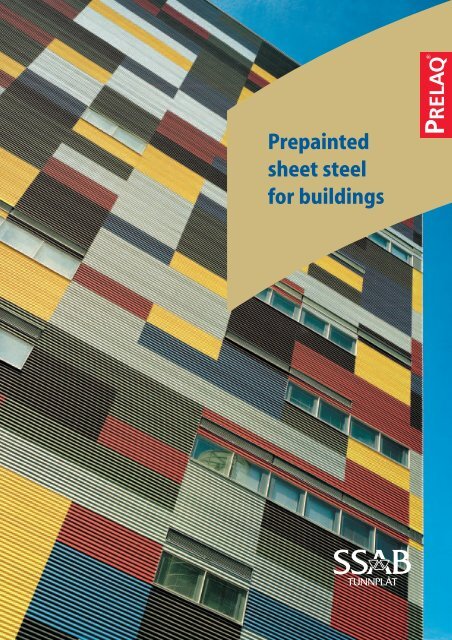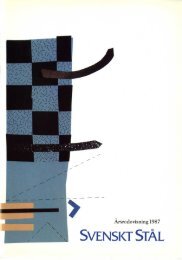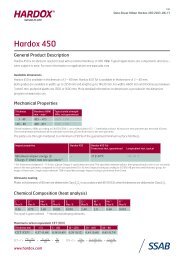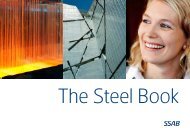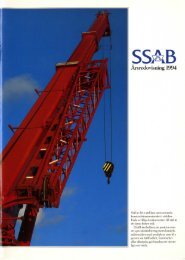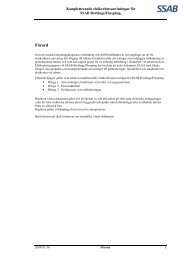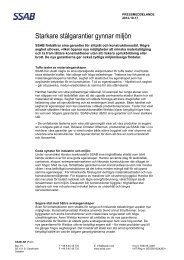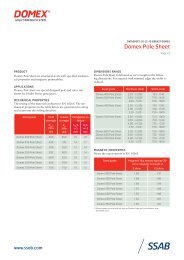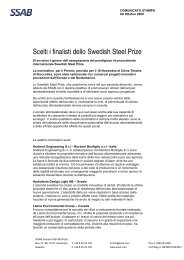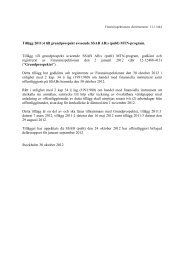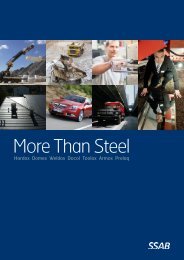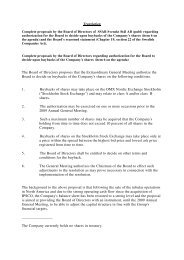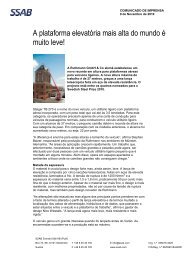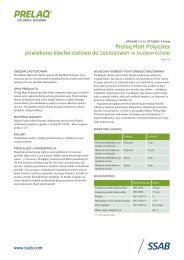Prepainted sheet steel for buildings - SSAB
Prepainted sheet steel for buildings - SSAB
Prepainted sheet steel for buildings - SSAB
You also want an ePaper? Increase the reach of your titles
YUMPU automatically turns print PDFs into web optimized ePapers that Google loves.
<strong>Prepainted</strong><br />
<strong>sheet</strong> <strong>steel</strong><br />
<strong>for</strong> <strong>buildings</strong>
On the cover: IThis Media College is located in the new Arabiastranden district of Helsinki City, Finland.<br />
The Ark-house architectural practice has used the exciting design opportunities offered by prepainted<br />
<strong>steel</strong> <strong>sheet</strong> and its properties.The building is popularly known in Helsinki as the "Lego House".<br />
Foto:Jussi Tiainen<br />
Graphics Education Centre in Uppsala, Sweden. 6000 m 2 of long strip roofing of Prelaq Nova.
The use of coated <strong>steel</strong> <strong>sheet</strong> as building<br />
material increases its field of application<br />
<strong>for</strong> a number of reasons.The material can<br />
be <strong>for</strong>med into components by profiling,<br />
pressing or bending. It can be sheared<br />
and punched. The paint coat can be <strong>for</strong>mulated<br />
to give it a variety of properties<br />
to suit different applications and environments.<br />
In many ways, prepainted <strong>sheet</strong><br />
<strong>steel</strong> is an obvious material <strong>for</strong> the future.<br />
This publication is intended to assist<br />
in the important task of selecting the<br />
right product and offers advice on its use.<br />
CONTENTS:<br />
4 Why prepainted <strong>sheet</strong> <strong>steel</strong> <strong>for</strong> <strong>buildings</strong>?<br />
6 Products and applications<br />
8 Materials<br />
12 Testing and inspection of Prelaq<br />
14 Environmental properties<br />
16 Selecting the right material<br />
20 Prelaq is easy to work<br />
22 Detail design and installation<br />
24 Factors that affect the useful life of <strong>sheet</strong> <strong>steel</strong><br />
26 Maintenance <strong>for</strong> longer useful life of Prelaq<br />
28 Handling, storage and transport<br />
30 Technical support<br />
30 Further in<strong>for</strong>mation on Prelaq<br />
The in<strong>for</strong>mation in this publication is valid at the time of printing and is intended to<br />
provide general guidance <strong>for</strong> the use of the product. Subject to changes as a result of<br />
continual product development.The in<strong>for</strong>mation and data must not be regarded as<br />
guaranteed, unless specifically confirmed in writing.<br />
3
Why<br />
prepainted<br />
<strong>steel</strong> <strong>sheet</strong><br />
<strong>for</strong><br />
<strong>buildings</strong>?<br />
Coated <strong>steel</strong> <strong>sheet</strong> strip<br />
offers exceptional opportunities<br />
<strong>for</strong> creating attractive<br />
and functional <strong>buildings</strong>.<br />
The versatility of<br />
<strong>sheet</strong> <strong>steel</strong> in terms of <strong>for</strong>m<br />
and colour offers wide<br />
freedom to the architect<br />
and building owner.<br />
Prefabricated components<br />
made of Prelaq provide<br />
short building times and<br />
easy handling on site.<br />
Due to the good <strong>for</strong>mability<br />
of the <strong>sheet</strong> <strong>steel</strong> and<br />
paint coat, Prelaq can be<br />
used in advanced <strong>for</strong>ming<br />
operations.<br />
Prelaq is very well suited<br />
<strong>for</strong> roll<strong>for</strong>ming. Due to<br />
the recent development of<br />
sophisticated roll<strong>for</strong>ming<br />
machines, architects can<br />
design very modern <strong>buildings</strong>,<br />
virtually without<br />
limitations.<br />
In addition to being<br />
suitable <strong>for</strong> roll<strong>for</strong>ming,<br />
Prelaq <strong>sheet</strong> can be pressed<br />
and worked in a number of<br />
other ways. The paint<br />
systems and colours have<br />
been developed into an<br />
array of different colours,<br />
with the option of metallic<br />
4<br />
and textured surfaces.<br />
Prepainting has several<br />
objectives. It gives the<br />
<strong>sheet</strong> <strong>steel</strong> an attractive<br />
appearance, while also<br />
protecting it against corrosion.<br />
Since widely varying<br />
demands are made on<br />
appearance, outdoor<br />
durability and workability,<br />
Prelaq is available with a<br />
number of paint systems<br />
and with different <strong>steel</strong><br />
grades that impart different<br />
properties to the<br />
product. The zinc and<br />
paint coatings on the <strong>steel</strong><br />
assure that Prelaq has good<br />
resistance to corrosion.<br />
<strong>SSAB</strong> Tunnplåt has long<br />
experience of producing<br />
prepainted <strong>sheet</strong> <strong>steel</strong>. Our<br />
choice of paint systems<br />
and our way of manufacturing<br />
our products<br />
are based on knowledge<br />
accumulated over 30 years.<br />
Prelaq cladding on <strong>buildings</strong><br />
provides safe and<br />
durable weather protection,<br />
low maintenance<br />
costs, and thus sound<br />
economics. Coil coating is<br />
an industrially controlled<br />
process, and so is the<br />
subsequent production of<br />
components in tailored<br />
sizes. This contributes to<br />
rational building and<br />
short construction times.<br />
Steel is an environmentally<br />
appropriate building<br />
material. At the end of<br />
its useful life, it can be<br />
remelted and used <strong>for</strong><br />
new products.<br />
<strong>SSAB</strong> Tunnplåt supplies<br />
Prelaq to its customers in<br />
the <strong>for</strong>m of coils, and the<br />
material is then used <strong>for</strong><br />
manufacturing various<br />
components and products.
For a true colour reproduction, order a colour chart at www.prelaq.com<br />
5
Products and<br />
applications<br />
6<br />
Profiled <strong>sheet</strong> <strong>steel</strong><br />
By being <strong>for</strong>med into<br />
a linear profile in a roll<strong>for</strong>ming<br />
line, flat <strong>sheet</strong><br />
can be given stiffness and<br />
strength, which enables<br />
it to become load bearing.<br />
Profiles can be used in a<br />
variety of ways, usually <strong>for</strong><br />
roofing and wall cladding,<br />
Steel roof tiles<br />
Steel roof tiles are used<br />
principally <strong>for</strong> residential<br />
<strong>buildings</strong>. Steel tiles are<br />
light compared to concrete<br />
tiles, <strong>for</strong> instance, and<br />
can very well be used <strong>for</strong><br />
replacing concrete tiles<br />
or pantiles.<br />
but also <strong>for</strong> floor structures<br />
and load bearing <strong>sheet</strong> <strong>for</strong><br />
wide roof spans.<br />
Profiled <strong>sheet</strong> <strong>steel</strong><br />
represents a major field<br />
of application <strong>for</strong> Prelaq.<br />
Steel with standardized<br />
structural <strong>steel</strong> is used <strong>for</strong><br />
load bearing profiles.<br />
Just like profiled <strong>sheet</strong>,<br />
<strong>steel</strong> roof tiles are produced<br />
in a roll<strong>for</strong>ming and<br />
pressing line. This enables<br />
a <strong>sheet</strong> to be <strong>for</strong>med into<br />
attractive shapes.
Long strip roofing<br />
Long strip roofing dates<br />
back to the 19th century<br />
and is largely a craft. The<br />
<strong>sheet</strong>s are joined together<br />
by folding. Coated <strong>steel</strong><br />
<strong>sheet</strong> is now used <strong>for</strong> this<br />
application.<br />
Sandwich panels<br />
The use of sandwich<br />
panels, principally as wall<br />
cladding or roofing material,<br />
is an attractive option<br />
<strong>for</strong> profiled <strong>sheet</strong> <strong>steel</strong> walls<br />
and other prefabricated<br />
element construction.<br />
A sandwich panel consists<br />
of a core of cellular plastic<br />
or mineral wool, and an<br />
outer <strong>sheet</strong> <strong>steel</strong> skin<br />
Long strip roofing<br />
con<strong>for</strong>ms to very strict<br />
demands on functionality,<br />
flexibility and appearance,<br />
and can also be used on<br />
roofs with curved or<br />
spherical surfaces.<br />
bonded to each side of<br />
the core. The core material<br />
and outer skins interact<br />
to make the elements very<br />
strong and thus suitable<br />
<strong>for</strong> use as load bearing<br />
elements <strong>for</strong> wide spans.<br />
Sandwich panels can be<br />
fitted quickly, and provide<br />
good thermal insulation<br />
and air tightness.<br />
External cassettes<br />
External cassettes of <strong>sheet</strong><br />
<strong>steel</strong> are one of the frontage<br />
material options that<br />
provide great aesthetic<br />
freedom. Prelaq offers<br />
opportunities <strong>for</strong> creating<br />
a wide variety of expressions,<br />
<strong>for</strong> creating different<br />
pattern effects, and <strong>for</strong><br />
emphasizing certain parts<br />
Rain gutter systems<br />
More than 90% of all<br />
downpipes and gutters<br />
in Sweden are made of<br />
prepainted <strong>sheet</strong> <strong>steel</strong>.<br />
<strong>Prepainted</strong> <strong>sheet</strong> <strong>steel</strong><br />
products are also gaining<br />
increasingly widespread<br />
use in the rest of Europe.<br />
7<br />
of the frontage. This is<br />
achieved by varying the<br />
widths, lengths and<br />
heights of the cassettes<br />
and the sizes of the joints<br />
between them. Further<br />
literature on frontage<br />
cassettes is available from<br />
<strong>SSAB</strong> Tunnplåt.<br />
Manufacturers produce<br />
effective and easily installed<br />
systems based on double<br />
sided prepainted <strong>sheet</strong> <strong>steel</strong>.
Materials<br />
Galvanized <strong>sheet</strong> <strong>steel</strong> as<br />
the substrate material<br />
The substrate of all Prelaq<br />
products consists of<br />
galvanized <strong>sheet</strong> <strong>steel</strong>.<br />
The mechanical properties<br />
of the <strong>steel</strong> are selected to<br />
suit the application of<br />
the end product. As an<br />
Table 1<br />
8<br />
Hot dipped galvanized structural <strong>steel</strong> con<strong>for</strong>ming to European standard EN 10 326<br />
<strong>SSAB</strong> European standard Min. yield strength, Min. tensile strength, Elongation A80 1<br />
designation designation R p0.2 N/mm 2 R m N/mm 2 %min.<br />
SUB 250 S250GD+Z 250 330 19<br />
SUB 280 S280GD+Z 280 360 18<br />
SUB 320 S320GD+Z 320 390 17<br />
SUB 350 S350GD+Z 350 420 16<br />
Designation example: S250GD+Z275 (where Z275 is the weight of the zinc coating)<br />
1) For t≤ 0.70 mm, the value is two units lower.<br />
Table 2<br />
Hot dipped galvanized mild <strong>steel</strong>s con<strong>for</strong>ming to European standard EN 10 327<br />
<strong>SSAB</strong> European standard Yield strength, Max. tensile strength, Elongation A80 1<br />
designation designation R p0.2 N/mm 2 approx. R m N/mm 2 %min.<br />
PLX - 180 36<br />
FAX DX52D+Z 300 420 26<br />
FA DX51D+Z - 500 22<br />
1) For t≤ 0.70 mm, the value is two units lower.<br />
Paint layers<br />
1. Protective film (in some cases)<br />
2.Top coat<br />
3. Primer<br />
4. Passivation layer<br />
5. Zinc coating<br />
6. Steel <strong>sheet</strong><br />
7. Reverse side coating<br />
6<br />
5<br />
4<br />
3<br />
1<br />
example, structural <strong>steel</strong> is<br />
used <strong>for</strong> a component<br />
designed to meet clearly<br />
defined strength requirements<br />
(see Table 1).<br />
Formable mild <strong>steel</strong>s are<br />
used if the <strong>sheet</strong> is to be<br />
<strong>for</strong>med in a severe manner<br />
or if the <strong>sheet</strong> is to be<br />
2<br />
worked manually, <strong>for</strong><br />
instance, by a <strong>sheet</strong> metal<br />
worker (see Table 2).<br />
7<br />
4<br />
5<br />
6
Zinc coating<br />
The zinc coating provides<br />
the <strong>sheet</strong> <strong>steel</strong> with double<br />
protection against corrosion.<br />
It serves as an effective<br />
barrier that excludes oxygen<br />
and moisture, and it provides<br />
cathodic protection<br />
at cut edges and at any<br />
Table 3<br />
point where the zinc coating<br />
has been damaged.<br />
If the <strong>sheet</strong> is exposed to<br />
moisture, a galvanic<br />
couple will be <strong>for</strong>med,<br />
in which the <strong>steel</strong> is the<br />
cathode and the zinc is<br />
the anode. The anode<br />
"sacrifices itself " and <strong>for</strong>ms<br />
corrosion products that<br />
prevent further damage.<br />
Further corrosion is impeded<br />
and the process ceases.<br />
A limited number of<br />
zinc coating thicknesses<br />
(see Table3) are used<br />
<strong>for</strong> Prelaq <strong>for</strong> building<br />
applications.<br />
Designation Coating mass, g/m 2 (1 Coating thickness per side<br />
(approx.), µm<br />
Z 275 275 20<br />
Z 350 350 25<br />
1) The metal coating is measured in weight classes and specifies the total weight of metal on both sides of the <strong>sheet</strong>.<br />
Measured in accordance with the triple spot test specified in EN 10 327.<br />
Table 4<br />
Range of sizes 1<br />
Zinc coating<br />
Width mm Thickness mm<br />
700-1500 0.4-1.5<br />
1) The thickness and width cannot be combined freely, and are dependent on<br />
the grade of <strong>steel</strong> and the weight per metre run.<br />
9
Paint systems <strong>for</strong><br />
different requirements<br />
Prelaq is available <strong>for</strong> a<br />
number of applications.<br />
The <strong>sheet</strong> <strong>steel</strong> can be<br />
coated with different paint<br />
systems in order to match<br />
Prelaq to different environmental<br />
conditions and<br />
quality requirements.<br />
Table 5<br />
10<br />
Paint systems<br />
Paint system Paint type Surface<br />
Prelaq Nova Polyester Textured<br />
Prelaq Polyester Polyester Smooth<br />
Prelaq Matt Polyester Polyester Textured<br />
Prelaq P 200 Plastisol Embossed<br />
Prelaq PVDF PVDF Smooth<br />
Paint systems<br />
Prelaq Nova is a special extra-thick variant of polyester<br />
coating. It has a wear-resistant, textured surface achieved<br />
by polymer grains being mixed into the top coating. It also<br />
has better <strong>for</strong>ming properties than ordinary polyester.<br />
Prelaq Polyester is a smooth polyester coating. Polyester<br />
is a cost-effective system and is currently the most common<br />
paint system <strong>for</strong> <strong>sheet</strong> <strong>steel</strong> <strong>for</strong> the building industry.<br />
Prelaq Matt Polyester is a matt polyester coating with<br />
a textured surface.<br />
Its properties are otherwise similar to the above coating.<br />
Prelaq P 200 is a thick plastisol coating with an embossed<br />
surface that has high mechanical wear resistance and<br />
high resistance to corrosion. Prelaq P 200 is easy to work<br />
and can be bent without limitations.<br />
Prelaq PVDF is a smooth coating.The coating has excellent<br />
colour fastness, and PVDF is there<strong>for</strong>e often specified<br />
wherever strict demands are made on the paint retaining<br />
its appearance <strong>for</strong> a very long time. Prelaq PVDF<br />
can be supplied with a protective film that prevents<br />
damage to the surface during transport and fitting.<br />
Prelaq NoConDrop is a special <strong>sheet</strong> <strong>for</strong> roofing in humid<br />
environments.The underside of Prelaq NoConDrop is<br />
coated with a thin fabric capable of absorbing condensation<br />
and preventing condensation dripping. For further in<strong>for</strong>mation,<br />
see the special publication <strong>for</strong> Prelaq NoConDrop.<br />
The paint system used on the front of the <strong>sheet</strong> <strong>steel</strong> is<br />
principally Prelaq Polyester.<br />
Prelaq reverse side paint consists as standard of a<br />
coating based on epoxy paint. It is <strong>for</strong>mulated to suit<br />
adhesive bonding applications.<br />
The paint coatings have<br />
been developed together<br />
with paint suppliers both<br />
on the basis of laboratory<br />
tests and by following up<br />
the material in practical<br />
service in construction<br />
over a period of many<br />
years. Detailed facts<br />
concerning every paint<br />
system are given in special<br />
product leaflets. Data concerning<br />
our paint coatings<br />
is assembled in a material<br />
specification in a pocket at<br />
the end of this publication.<br />
Applications<br />
Prelaq Nova is used <strong>for</strong> long strip roofing, profiled <strong>sheet</strong>,<br />
<strong>steel</strong> roof tiles, voil components, and external panels.<br />
Prelaq Polyester is used principally <strong>for</strong> profiled <strong>sheet</strong><br />
<strong>steel</strong> and associated fittings, and is intended <strong>for</strong> roofing<br />
and externals panels to which normal requirements apply.<br />
Prelaq Matt Polyester is particularly well suited <strong>for</strong> <strong>steel</strong><br />
roof tiles.<br />
Prelaq P 200 is used mainly <strong>for</strong> external panels and fittings<br />
in corrosive environments, also in areas close to the sea.<br />
Should not be used in central and southern Europe.<br />
Prelaq PVDF is used mainly <strong>for</strong> external panels,<br />
wherever very strict demands are made on colour<br />
fastness. Not suitable <strong>for</strong> use close to the sea.<br />
Prelaq NoConDrop is used mainly <strong>for</strong> producing profiled<br />
<strong>sheet</strong> with condensation-absorbing properties.<br />
The <strong>sheet</strong> is used <strong>for</strong> attic areas and <strong>for</strong> uninsulated<br />
<strong>buildings</strong> and cantilever roofs.<br />
Prelaq reverse side paint is used on the back of the <strong>sheet</strong>.<br />
This paint system is designed to meet less stringent<br />
demands than other paint systems on protection against<br />
corrosion and resistance to mechanical wear.The reverse<br />
side of the <strong>sheet</strong> can be painted with other paint<br />
systems to special order.
Coating properties<br />
These diagrams give a guide<br />
to the technical properties<br />
of the material in a number<br />
of important areas.<br />
Protection<br />
against corrosion<br />
Protection<br />
against corrosion<br />
Prelaq Nova<br />
Maintainability<br />
Prelaq PVDF<br />
The greater the distance<br />
from the centre of the<br />
figure, the higher the<br />
value of the corresponding<br />
property.<br />
Wear resistance Workability<br />
Maintainability<br />
Wear resistance Workability<br />
Colour fastness<br />
Colour fastness<br />
Protection<br />
against corrosion<br />
Protection<br />
against corrosion<br />
Prelaq Polyester, Prelaq Matt Polyester<br />
Paint applied by rollers<br />
Zinc coated <strong>sheet</strong> is painted<br />
in an accurately controlled<br />
continuous process. The<br />
<strong>sheet</strong> <strong>steel</strong> is carefully<br />
cleaned and chemically<br />
pre-treated, and the paint<br />
is then applied by rollers in<br />
two stages, i.e. primer and<br />
top coat. Between the two<br />
coatings, the paint is dried<br />
and cured in an oven.<br />
The <strong>sheet</strong> can also be<br />
painted on both sides with<br />
a two-coat system.<br />
Maintainability<br />
Wear resistance Workability<br />
Prelaq P200<br />
Maintainability<br />
Wear resistance Workability<br />
11<br />
Colour fastness<br />
Colour fastness<br />
The second oven is<br />
followed by an embossing<br />
and lamination unit, in<br />
which thicker coatings are<br />
embossed with a pattern<br />
or the fabric <strong>for</strong><br />
NoConDrop <strong>sheet</strong> is<br />
applied. The reverse side<br />
is marked with the Prelaq<br />
logo, which allows <strong>for</strong><br />
subsequent identification<br />
of the material.
Testing and<br />
inspection<br />
of Prelaq<br />
Exposure outdoors in a marine environment<br />
Standardized methods are<br />
used <strong>for</strong> testing prepainted<br />
<strong>sheet</strong> <strong>steel</strong>.<br />
The durability of Prelaq<br />
is continuously assessed by<br />
exposure outdoors.<br />
Adhesion test as per EN 13 523-6<br />
12<br />
Sheet <strong>steel</strong> test pieces<br />
are constantly exposed to<br />
the atmosphere on the west<br />
coast of Sweden, and also<br />
in Poland and Florida,<br />
USA.
Marking on the reverse side of the <strong>sheet</strong>.<br />
Prelaq material<br />
undergoes comprehensive<br />
testing to determine<br />
the following typical<br />
properties:<br />
•Thickness of the<br />
paint film<br />
•Adhesion<br />
•Colour<br />
• Gloss<br />
•Bendability<br />
•Rapid de<strong>for</strong>mation<br />
•Drawability according to<br />
the Erichsen cupping test.<br />
The requirements and<br />
test methods con<strong>for</strong>m<br />
to European standard<br />
EN 10 169-1.<br />
The <strong>steel</strong> is subjected to<br />
tensile testing in order to<br />
document its mechanical<br />
properties.<br />
Our quality inspection<br />
during production mean<br />
that we comply with<br />
national and international<br />
standards and approvals.<br />
13<br />
<strong>SSAB</strong> Tunnplåt has gained<br />
certification to show that<br />
the company works to a<br />
quality system that follows<br />
the ISO 9002 standard.<br />
Our <strong>sheet</strong> <strong>steel</strong> is marked<br />
so that is can be identified.<br />
Several of our products<br />
have been certified in<br />
countries such as the UK,<br />
Germany and Russia.
Environmental<br />
properties<br />
Recycling of <strong>steel</strong><br />
Steel plays an important<br />
role in the development of<br />
society and is an indispensable<br />
material in many<br />
applications. Iron and <strong>steel</strong><br />
have always been recycled<br />
and thus comprise a natural<br />
element in modern<br />
environmentally aware<br />
societies. Iron is a metal<br />
that is essential to humanity,<br />
i.e. it is important in<br />
enabling human activities<br />
to be maintained. Iron and<br />
<strong>steel</strong> emit no substances<br />
that could be harmful to<br />
the environment or to<br />
human health.<br />
14<br />
Ore mining<br />
Recycling<br />
Recycled<br />
<strong>steel</strong> based<br />
industry<br />
Raw iron from<br />
blast furnace<br />
Manufacturing<br />
industry<br />
Hot dipped galvanized<br />
<strong>sheet</strong> <strong>steel</strong> from the<br />
environmental aspect<br />
Zinc and iron distinguish<br />
themselves from other<br />
metals by being exceptionally<br />
important to<br />
our existence.<br />
The life of human<br />
beings, animals and plants<br />
is dependent on zinc.<br />
One of the best ways<br />
of protecting <strong>steel</strong> against<br />
corrosion is to coat it with<br />
a thin layer of zinc. The<br />
durability of this anti-corrosion<br />
treatment may be<br />
anything from a few years<br />
to more than 100 years,<br />
Raw <strong>steel</strong> from<br />
converter<br />
Rolling<br />
into <strong>sheet</strong><br />
depending on the thickness<br />
of the zinc coating.<br />
In the galvanized <strong>steel</strong><br />
<strong>sheet</strong> substrate the zink is<br />
used to provide an anticorrosion<br />
resistant metal<br />
coating. Galvanized <strong>sheet</strong><br />
<strong>steel</strong> is 100% remeltable<br />
and recyclable. The zinc is<br />
contained in the flue gas<br />
dust <strong>for</strong>med in the melting<br />
process. This dust is<br />
collected and the zinc<br />
is recovered from it.<br />
<strong>Prepainted</strong> <strong>sheet</strong> <strong>steel</strong> from<br />
the environmental aspect<br />
More than 99% of the solvents<br />
used in painting coil
coated <strong>steel</strong> strip are retained<br />
in the process. The<br />
solvents are burned, and<br />
the combustion energy is<br />
recovered and is returned<br />
to the process <strong>for</strong> drying<br />
the paint. The processes<br />
we use <strong>for</strong> coating the <strong>steel</strong><br />
are generally superior<br />
from the environmental<br />
aspect to the methods<br />
employed in the engineering<br />
industry.<br />
<strong>Prepainted</strong> <strong>sheet</strong> <strong>steel</strong> is<br />
very light in relation to its<br />
load bearing and covering<br />
capabilities. This makes the<br />
material easy to use in construction<br />
and to transport,<br />
which thereby saves energy.<br />
Correct choice of product<br />
and good maintenance<br />
ensure a long useful life,<br />
which is beneficial from<br />
the environmental aspect.<br />
If the <strong>sheet</strong> <strong>steel</strong> cannot<br />
be reused, it can easily be<br />
recycled by remelting.<br />
Environmental impact of<br />
<strong>sheet</strong> <strong>steel</strong> production<br />
<strong>SSAB</strong> Tunnplåt has been<br />
pursuing active environmental<br />
work <strong>for</strong> many<br />
years. This includes work<br />
on raw materials, residual<br />
products, chemicals, risk<br />
analyses and measures<br />
aimed at restricting emissions<br />
to the atmosphere<br />
and to watercourses, conservation<br />
of energy, etc.<br />
Processes and products<br />
are developed from the<br />
environmental and life<br />
cycle perspectives.<br />
Environmental<br />
specifications<br />
The properties of Prelaq<br />
from the environmental<br />
aspect are described in<br />
our environmental<br />
specification <strong>sheet</strong>s.<br />
15
Selecting<br />
the right<br />
material<br />
For every application,<br />
there is an optimal<br />
combination of <strong>steel</strong>, zinc<br />
coating and paint coating.<br />
The factors that must be<br />
taken into account when<br />
selecting the paint coating<br />
and substrate material are:<br />
•Type ofapplication<br />
Table 6<br />
16<br />
• Expectations on appearance<br />
and long term<br />
colour fastness<br />
•Degree of working<br />
(<strong>for</strong>ming)<br />
•Degree ofexposure<br />
to mechanical wear<br />
•Corrosiveness of<br />
the environment<br />
Applications and material recommendations<br />
• Sun and heat<br />
•Future maintenance<br />
• Static strength of<br />
the product<br />
Table 6 gives our general<br />
recommendations <strong>for</strong><br />
some typical applications.<br />
Application Paint coating Zinc coating Steel grade 2<br />
Profiled <strong>sheet</strong> <strong>steel</strong> Prelaq Nova Z 275 SUB 250 – SUB 350<br />
<strong>for</strong> roofing Prelaq Polyester 420 YP<br />
Steel roof tiles Prelaq Nova Z 275 SUB 250 – SUB 350<br />
Prelaq Polyester<br />
Prelaq Matt Polyester<br />
Profiled <strong>sheet</strong> <strong>steel</strong> Prelaq Nova Z 275 SUB 250 – SUB 350<br />
<strong>for</strong> walls Prelaq Polyester<br />
Prelaq PVDF<br />
Sandwich panels Prelaq Nova Z 275 SUB 250 – SUB 350<br />
Prelaq PVDF<br />
Long strip roofing Prelaq Nova Z 350 PLX<br />
External panels Prelaq Nova Z 275 FA<br />
Prelaq PVDF<br />
Roof drainage products Prelaq Nova DS 1 Z 275 FAX, PLX<br />
Fittings Same as connected materials. Z 275 FA, SUB 250 – SUB 350<br />
1. Sheet coated on both sides<br />
2. See also Table 2 on page 8
Colour and gloss<br />
Colour, surface gloss and<br />
durability of the paint<br />
coating are the factors that<br />
are most important <strong>for</strong> the<br />
appearance of a building.<br />
In addition to being suitable<br />
<strong>for</strong> the building<br />
itself, the colour scheme<br />
must also make the building<br />
blend neatly into the<br />
surroundings.<br />
The following four simple<br />
pieces of advice will make<br />
it easy to choose the<br />
colour scheme:<br />
•A discreet colour is preferable<br />
to a bright colour.<br />
•Preferably use a few<br />
colours rather than many.<br />
•Bear in mind the<br />
surroundings and the<br />
overall impression.<br />
Table 7<br />
Choice of paint coatings to suit the corrosiveness of the atmosphere<br />
Corrosion Corrosiveness of Examples of environment Paint system that is suitable<br />
class the environment with regard to the environment<br />
C1 Very low Heated areas in which the air is dry and All<br />
has insignificant amounts of pollutants.<br />
C2 Low Atmospheres with low contents of All<br />
pollutants. Rural areas.<br />
C3 Moderate Atmospheres with a certain amount of salt All<br />
or moderate contents of pollutants. Areas<br />
affected to some extent by the sea coast.<br />
C4 High Atmospheres with moderate contents of Prelaq Nova<br />
salt or significant contents of air pollutants. Prelaq P200<br />
Industrial and coastal areas.<br />
C5-I Very high (industrial) Industrial areas with high air humidity Prelaq P2001 and an aggressive atmosphere Prelaq Nova 1<br />
C5-M Very high (marine) Coastal and offshore areas with Prelaq Nova 1<br />
high salt contents Prelaq P200 1<br />
1.The choice of material should be discussed with <strong>SSAB</strong> Tunnplåt.<br />
•Obtain the advice of<br />
experienced professionals.<br />
Colour deviations between<br />
the different deliveries are<br />
measured in Cielab units.<br />
One Cielab unit is normally<br />
the highest permissible<br />
colour deviation<br />
from our reference.<br />
Certain colour systems<br />
are more sensitive than<br />
others to colour deviations.<br />
These include<br />
metallic colours and Matt<br />
Polyester.<br />
For these paint systems,<br />
ef<strong>for</strong>ts should be made to<br />
use the same production<br />
batch of <strong>sheet</strong> <strong>for</strong> the roof<br />
or external surface, and<br />
the <strong>sheet</strong>s must be fitted<br />
so that the arrows on the<br />
reverse side of the <strong>sheet</strong> all<br />
point in the same direction.<br />
17
Prelaq<br />
is easy<br />
to work<br />
Forming of Prelaq into a trapezoidal profile.<br />
<strong>Prepainted</strong> <strong>sheet</strong> <strong>steel</strong> is<br />
<strong>for</strong>med mainly by bending<br />
or roll<strong>for</strong>ming. Cutting is<br />
carried out by shearing or<br />
slitting of the <strong>sheet</strong>. It is<br />
important to ensure that<br />
all tools used in working<br />
are clean and have smooth<br />
surfaces. Tools that were<br />
previously used <strong>for</strong> coldrolled<br />
or galvanized <strong>sheet</strong><br />
<strong>steel</strong> must be cleaned be<strong>for</strong>e<br />
they are used <strong>for</strong> working<br />
prepainted materials.<br />
Radii produced by roll<strong>for</strong>ming<br />
and bending must<br />
be suitable <strong>for</strong> the bending<br />
properties of the material<br />
employed, as specified in<br />
the enclosure in the pocket<br />
at the end of this brochure<br />
and in the special product<br />
leaflet. In tool design,<br />
ef<strong>for</strong>ts should be made<br />
to use the largest possibly<br />
radii. This will ensure<br />
flexibility in the selection<br />
of materials, will allow <strong>for</strong><br />
<strong>for</strong>ming at lower temperatures<br />
without damage, and<br />
will minimize the risk of<br />
microscopic cracks in the<br />
paint coating.<br />
20<br />
It is always advisable to<br />
<strong>for</strong>m the <strong>sheet</strong> at room<br />
temperature. There are<br />
special recommendations<br />
(see the enclosure) <strong>for</strong><br />
long strip roofing material<br />
(PLX).<br />
Roll<strong>for</strong>ming<br />
Roll<strong>for</strong>ming consists of a<br />
flat strip being fed into a<br />
roll<strong>for</strong>ming machine, in<br />
which the <strong>sheet</strong> is <strong>for</strong>med<br />
in a number of stages by<br />
successive rolls into the<br />
required profile.<br />
Roll<strong>for</strong>ming is particularly<br />
effective <strong>for</strong> <strong>for</strong>ming<br />
long profiles. The operation<br />
is fast and ensures<br />
good dimensional accuracy.<br />
Moreover, the method<br />
does not damage the<br />
paint coating.<br />
Every roll<strong>for</strong>ming tool<br />
set is designed <strong>for</strong> material<br />
of a certain thickness and<br />
with definite elastoplastic<br />
properties. The setting of<br />
the tools should there<strong>for</strong>e<br />
be matched to the grade of<br />
<strong>steel</strong> being used, in order<br />
to avoid problems with the<br />
tolerances of the profile<br />
being <strong>for</strong>med.<br />
The roll<strong>for</strong>ming tools<br />
should be designed so that<br />
the finished inside bend<br />
radius of the <strong>sheet</strong> is not<br />
smaller than the value<br />
specified in Tables 1 and 5<br />
in the enclosure.<br />
Water soluble lubricants<br />
can be used in roll<strong>for</strong>ming,<br />
but not lubricants that<br />
contain solvents or substances<br />
that may be harmful<br />
to the paint coating.<br />
Pressing<br />
Prelaq is commonly used<br />
<strong>for</strong> producing pressed<br />
components. The benefit<br />
of the paint coating is that<br />
separate lubrication is<br />
often unnecessary, particularly<br />
<strong>for</strong> shallow parts.<br />
The material can be deep<br />
drawn, which in practice<br />
represents a combination<br />
of drawing and stretch<br />
<strong>for</strong>ming. The <strong>for</strong>mability<br />
improves with decreasing<br />
strength of the <strong>steel</strong>, and<br />
mild <strong>steel</strong>s such as PLX<br />
are there<strong>for</strong>e often used.
Bending<br />
Bending can be carried<br />
out in an edge pressing or<br />
machine. In the bending<br />
process, the outside of the<br />
<strong>sheet</strong> is stretched while<br />
the inside is compressed.<br />
The amount of stretching<br />
increases as the bending<br />
radius is reduced. The<br />
bendability of Prelaq is<br />
specified in the enclosure,<br />
where the minimum<br />
permissible bending radius<br />
is specified <strong>for</strong> bending the<br />
various <strong>steel</strong> grades and<br />
the paint coatings. The<br />
maximum value <strong>for</strong> each<br />
combination of <strong>sheet</strong> <strong>steel</strong><br />
and paint applies (see the<br />
enclosure, Tables 1 and 5).<br />
The fundamental<br />
conditions <strong>for</strong> successful<br />
bending of prepainted<br />
<strong>sheet</strong> <strong>steel</strong> in edge pressing<br />
are as follows:<br />
•The tools must be clean,<br />
in good condition and<br />
without sharp burrs and<br />
sharp edges. The latter is<br />
particularly important in<br />
the upper part of the V<br />
in a V die.<br />
•Protective tape or plastic<br />
film should be used in<br />
the tools when bending<br />
Prelaq PVDF, Prelaq<br />
Nova and Prelaq<br />
Polyester.<br />
•V-shaped dies should<br />
be used in order to avoid<br />
damage to the paint<br />
coating.<br />
•The blade should be<br />
set so that it does not<br />
bottom in the die.<br />
•When the <strong>sheet</strong> is bent<br />
through 180°, care must<br />
be taken to avoid damage<br />
to the coating during the<br />
Pressing of a part <strong>for</strong> roof drainage products.<br />
final compression. The<br />
<strong>sheet</strong> bending radius<br />
should be 1-3 mm, so<br />
that the selected paint<br />
system and <strong>steel</strong> will be<br />
able to withstand the<br />
bending operation<br />
without cracking.<br />
A soft material between<br />
the <strong>sheet</strong> <strong>steel</strong> and the tool<br />
will reduce the risk of<br />
damage.<br />
Shearing<br />
When shearing Prelaq<br />
with a thick paint coating,<br />
it is advisable to begin the<br />
cut on the reverse side of<br />
the <strong>sheet</strong>. The burrs<br />
occurring will then be<br />
concealed and protected<br />
by the paint coating.<br />
Carefully remove any<br />
swarf, so that it will not<br />
be trapped in the paint<br />
coating. All shearing<br />
should be carried out at<br />
right angles to the <strong>sheet</strong><br />
surface. A suitable clearance<br />
between the shearing<br />
blade, punch and die may<br />
vary between 6% and 12%<br />
of the <strong>sheet</strong> thickness,<br />
depending on factors such<br />
as the strength of the <strong>steel</strong>.<br />
Make sure that the blades<br />
are always sharp.<br />
Using blunt tools <strong>for</strong><br />
shearing increases the risk<br />
of edge corrosion.<br />
Slitting<br />
Edge trimming and<br />
slitting into narrow strip<br />
are carried out by a pair<br />
of rolls made of tool <strong>steel</strong>.<br />
The necessary number of<br />
rolls is mounted on parallel<br />
shafts. The grade of tool<br />
<strong>steel</strong> and the clearance<br />
between the rolls depends<br />
on the material being slit.<br />
The following guideline<br />
values can be used <strong>for</strong> the<br />
horizontal clearance:<br />
•For workpiece material<br />
with a tensile strength<br />
R m 450 N/mm 2 , the clearance<br />
should be around<br />
8% of the thickness.<br />
Cutting<br />
Do not use a grinding<br />
wheel to cut prepainted<br />
<strong>sheet</strong> <strong>steel</strong>, since this<br />
would increase the risk<br />
of edge corrosion on the<br />
cut surface. Grinding grit<br />
also causes damage to the<br />
coating and rusting of the<br />
grinding swarf. On the<br />
other hand, a nibbling<br />
machine can be used<br />
<strong>for</strong> cutting.
Detail<br />
design and<br />
installation<br />
Smedmarks in Täby.<br />
The environment is not<br />
the only factor that affects<br />
the useful life of Prelaq.<br />
The detail design and the<br />
way in which the <strong>sheet</strong> is<br />
worked and handled are<br />
also of major importance<br />
to the resistance of the<br />
<strong>sheet</strong> <strong>steel</strong> to external<br />
conditions.<br />
Fittings and <strong>sheet</strong> edges<br />
Avoid bare <strong>sheet</strong> edges in<br />
places on which water<br />
droplets could accumulate.<br />
If possible, bare <strong>sheet</strong><br />
edges should be folded<br />
over. Seamed fittings<br />
should be either folded<br />
over or folded together.<br />
Make sure that the lower<br />
end of the pro-filed <strong>sheet</strong><br />
has good air circulation.<br />
Conceal cut edges<br />
produced by nibbling.<br />
Extra protection <strong>for</strong><br />
cut edges in a corrosive<br />
environment<br />
Profiled <strong>sheet</strong> <strong>steel</strong> on a<br />
roof with a shallow pitch<br />
(
The surface to which the<br />
<strong>sheet</strong> <strong>steel</strong> is secured must<br />
not be such that it gives<br />
rise to depressions around<br />
the fastener in which water<br />
could accumulate.<br />
Fastener manufacturers<br />
supply detailed instructions<br />
<strong>for</strong> using their products.<br />
Agressive atmosphere<br />
Sheet <strong>steel</strong> should not be<br />
stored or mounted in<br />
the vicinity of damp and<br />
corrosive materials.<br />
Obtain the advice of <strong>SSAB</strong><br />
Tunnplåt if Prelaq is to<br />
used, <strong>for</strong> example, in a<br />
constantly humid environment,<br />
in areas in which<br />
the material is exposed to<br />
strong cleaning agents, or<br />
in animal housing.<br />
If metals that are more<br />
noble than zinc come into<br />
contact with the zinc coating,<br />
the <strong>sheet</strong> may sustain<br />
corrosion damage. Design<br />
the various parts so that<br />
water containing copper<br />
will not run over the prepainted<br />
<strong>sheet</strong> <strong>steel</strong>. Water<br />
containing copper may<br />
come, <strong>for</strong> example, from<br />
gutters, from window edge<br />
flashing made of copper,<br />
or from copper pipes.<br />
Take care not to<br />
damage the paint<br />
It is important not to<br />
cause unnecessary damage<br />
to the <strong>sheet</strong> <strong>steel</strong> during<br />
the installation work. The<br />
useful life of the <strong>sheet</strong> <strong>steel</strong><br />
will be extended if the<br />
paint coating is intact.<br />
Note that certain coatings<br />
can be supplied with a<br />
removable protective film.<br />
Clean the <strong>sheet</strong><br />
<strong>steel</strong> surface<br />
Remove any drilling swarf,<br />
nibbling swarf and pop<br />
rivet stems from the <strong>sheet</strong><br />
surface. In the longer<br />
term,any metal residues<br />
remaining on the surface<br />
will lead to discoloration<br />
and corrosion attack.<br />
23
Factors<br />
that affect<br />
the useful<br />
life of<br />
<strong>sheet</strong> <strong>steel</strong><br />
The environment<br />
The environment around<br />
the building will affect<br />
the paint coating. Several<br />
factors determine the time<br />
it will take be<strong>for</strong>e the paint<br />
is degraded. The four most<br />
important factors are:<br />
• Ultraviolet light from<br />
the sun, its intensity<br />
and duration.<br />
• Heat<br />
•The amount of rainfall<br />
and the total time during<br />
which the surface layer<br />
is exposed to moisture.<br />
• The amount of pollutants<br />
in the atmosphere.<br />
Sheet <strong>steel</strong> surfaces in<br />
"rain shadow" that rain<br />
cannot access to rinse<br />
away the impurities are<br />
more liable to corrode<br />
than other surfaces.<br />
• Marine atmosphere.<br />
Salt laden air is a further<br />
factor in seaside areas.<br />
This affects all surfaces of<br />
a building. We define a<br />
marine environment as<br />
the area up to one kilometre<br />
from the coast.<br />
24<br />
The geographical location<br />
is of major importance as<br />
regards the sunlight and<br />
heat to which the paint<br />
coating is subjected.<br />
Certain limitations apply<br />
to the choice of products<br />
<strong>for</strong> <strong>buildings</strong> in Central<br />
Europe and further south.<br />
Solar radiation causes<br />
heating of the <strong>sheet</strong> <strong>steel</strong>,<br />
which contributes to the<br />
degradation of the paint<br />
coating. Sheeting on<br />
insulated surfaces will be<br />
warmer that on uninsulated<br />
surfaces, since the<br />
insulating surface reduces<br />
the capacity available <strong>for</strong><br />
conducting away the heat.<br />
Roofs and walls<br />
– detailed design<br />
Roof surfaces are subjected<br />
to the highest environmental<br />
impact, particularly<br />
if the roof has a shallow<br />
pitch. The roof is then<br />
exposed to strong sunlight,<br />
moisture and dirt, and<br />
must often also withstand<br />
people walking on it and<br />
other mechanical wear.<br />
A roof on which people<br />
frequently walk should be<br />
provided with walkways.<br />
Shortcomings in detailed<br />
design may intensify the<br />
above environmental<br />
impact effects.<br />
Maintenance<br />
To ensure that time and<br />
the environment will not<br />
have unnecessary opportunities<br />
to damage the<br />
<strong>sheet</strong> <strong>steel</strong>, it is important<br />
to avoid damage to the<br />
coating, both during the<br />
construction work and at<br />
a later stage. If a tool or<br />
fitting is dropped onto the<br />
<strong>sheet</strong>, the paint coating<br />
will sustain minor damage.<br />
Such damage should be<br />
repaired with touch<br />
up paint.<br />
Choice of material<br />
If an unsuitable material is<br />
selected, its useful life will<br />
be shortened and increased<br />
maintenance work will be<br />
required on the building.<br />
UV light and heat are<br />
the most important factors<br />
that affect the useful life<br />
of the plastisol coating on<br />
Prelaq P200. The location<br />
of the <strong>sheet</strong> in relation to<br />
solar radiation is there<strong>for</strong>e<br />
of major importance.<br />
Water surfaces in the<br />
vicinity of the building<br />
intensify solar radiation<br />
by reflection from the<br />
water surface.
Maintenance<br />
<strong>for</strong> longer<br />
useful life<br />
of Prelaq<br />
Provided it receives regular<br />
maintenance, a <strong>sheet</strong> <strong>steel</strong><br />
roof may last 30-40 years<br />
or more. The <strong>sheet</strong> <strong>steel</strong><br />
roofs of some <strong>buildings</strong> in<br />
Sweden date back to 1832,<br />
and the <strong>sheet</strong> <strong>steel</strong> is still<br />
in good condition because<br />
of the regular inspection<br />
and maintenance it has<br />
received.<br />
A distinction is made<br />
between the aesthetic useful<br />
life and the functional<br />
useful life of the coating<br />
on prepainted <strong>sheet</strong> <strong>steel</strong>.<br />
The aesthetic useful life<br />
is the time up to the point<br />
when the appearance of<br />
the paint coat has changed<br />
to such an extent that it no<br />
longer meets the requirements.<br />
The colour change<br />
26<br />
of roofing material that is<br />
considered acceptable<br />
depends on who assesses<br />
the change and on the<br />
type of building involved.<br />
In certain cases, the limit<br />
of the aesthetic useful life<br />
is the point in time when<br />
the paint begins to flake off.<br />
The colour of the paint<br />
coating affects the aesthetic<br />
useful life. Light colours<br />
and dark colours, <strong>for</strong><br />
example, have different<br />
properties. If the proven<br />
Prelaq standard colours<br />
are selected, this will<br />
ensure that the paint will<br />
meet all of the specified<br />
requirements.<br />
The useful life also<br />
depends on whether the<br />
material is used <strong>for</strong> wall<br />
cladding or roofing, the<br />
roof pitch, the orientation<br />
of the surface (such as north<br />
or south), and whether the<br />
<strong>sheet</strong> is exposed to an<br />
inland or coastal environment.<br />
When estimating<br />
the useful life of the paint<br />
coating, it is also important<br />
to take into account<br />
the environmental impact<br />
of local factory emissions<br />
and traffic.<br />
An undamaged coating<br />
of Prelaq Nova and Prelaq<br />
PVDF in a normal environment<br />
can be expected<br />
to have an aesthetic useful<br />
life of at least 20 years,<br />
while the useful life of<br />
Prelaq Polyester and Prelaq<br />
P200 can be expected to<br />
be at least 15 years.
The functional useful life<br />
is the time up to the point<br />
when the <strong>sheet</strong> <strong>steel</strong> can<br />
no longer protect the loadbearing<br />
structure of the<br />
building or the insulation<br />
behind the <strong>sheet</strong> <strong>steel</strong>.<br />
The time varies widely<br />
depending on the coating<br />
applied to the <strong>sheet</strong> <strong>steel</strong>,<br />
the type of zinc coating<br />
and, most importantly,<br />
the environment to which<br />
the <strong>sheet</strong> <strong>steel</strong> is exposed.<br />
Inspection and<br />
maintenance<br />
Regular inspection and<br />
maintenance will ensure<br />
that prepainted <strong>sheet</strong> <strong>steel</strong><br />
has a long useful life.<br />
The <strong>sheet</strong> surface should<br />
be inspected at least<br />
once a year.<br />
In most cases, maintenance<br />
is confined to washing<br />
the <strong>sheet</strong> <strong>steel</strong> a few times<br />
during its useful life,<br />
especially in a polluted<br />
atmosphere. But rain is<br />
often sufficient to keep<br />
the surface of the <strong>sheet</strong><br />
<strong>steel</strong> clean.<br />
Sheet <strong>steel</strong> mounted in<br />
"rain shadow", i.e. in areas<br />
that rain cannot reach to<br />
rinse away the dirt, should<br />
be inspected particularly<br />
carefully.<br />
Do not hesitate to<br />
consult <strong>SSAB</strong> Tunnplåt<br />
<strong>for</strong> practical advice.<br />
Advice is also compiled<br />
in the brochure entitled<br />
"Inspection and maintenance<br />
of prepainted<br />
<strong>steel</strong> <strong>sheet</strong>".<br />
Repainting<br />
Depending on the<br />
demands made on a building<br />
clad in <strong>sheet</strong> <strong>steel</strong>, it<br />
may be advisable in time<br />
to restore the surface coating.<br />
This may be done by<br />
replacing the <strong>sheet</strong> or by<br />
overpainting it.<br />
A suitable time <strong>for</strong> over<br />
painting can be determined<br />
by regular inspection<br />
of the paint coat. The <strong>sheet</strong><br />
should be overpainted<br />
be<strong>for</strong>e the existing paint<br />
coat has lost is adhesion to<br />
the <strong>sheet</strong> <strong>steel</strong>. A suitable<br />
time <strong>for</strong> repainting should<br />
preferably be assessed by<br />
an expert. The normal<br />
time be<strong>for</strong>e repainting<br />
varies with the environmental<br />
conditions and the<br />
paint system selected.<br />
27<br />
Particular care should be<br />
taken when overpainting<br />
a plastisol coating. In this<br />
case, the conditions <strong>for</strong><br />
repainting should be<br />
assessed by an experienced<br />
person.<br />
Several different makes<br />
and systems of paints <strong>for</strong><br />
repainting are available on<br />
the market.
Handling,<br />
storage and<br />
transport<br />
<strong>Prepainted</strong> <strong>sheet</strong> <strong>steel</strong> is<br />
a quality product and<br />
must be correctly handled.<br />
Moisture, mechanical<br />
damage or other abuse<br />
may destroy the entire coil<br />
or <strong>sheet</strong> stack or some part<br />
of it. The following simple<br />
rules will enable you to<br />
avoid damage to the <strong>sheet</strong>:<br />
Dry conditions<br />
<strong>Prepainted</strong> and metalcoated<br />
<strong>sheet</strong> should be<br />
protected against moisture<br />
while in storage. Indoor<br />
storage in dry premises at<br />
a uni<strong>for</strong>m temperature is<br />
best. Rapid temperature<br />
fluctuations may cause<br />
condensation. Sheet <strong>steel</strong><br />
should there<strong>for</strong>e be stored<br />
far from doors that are<br />
28<br />
frequently opened and<br />
closed.<br />
If moisture has collected<br />
between the <strong>sheet</strong>s, the<br />
<strong>sheet</strong>s should be separated<br />
and left to dry in air.<br />
Profiled <strong>sheet</strong> stored<br />
outdoors must be covered<br />
but must be assured of<br />
good air circulation.<br />
Lifting<br />
Never use chains or <strong>steel</strong><br />
ropes <strong>for</strong> lifting prepainted<br />
<strong>sheet</strong> <strong>steel</strong>. If a <strong>for</strong>klift<br />
truck is used, fit protective<br />
sleeves to the <strong>for</strong>ks to<br />
prevent denting the <strong>sheet</strong>.<br />
A lifting device must not<br />
have sharp edges and its<br />
diameter should be the<br />
same as the inside diameter<br />
of the coil. If straps are<br />
used <strong>for</strong> lifting, edge<br />
protection should be<br />
arranged.<br />
Sheets should be lifted<br />
carefully from a <strong>sheet</strong><br />
stack and should not be<br />
allowed to slide on top of<br />
one another. This will<br />
avoid unnecessary scratch<br />
marks. Preferably use<br />
pneumatic or magnetic<br />
lifting devices.<br />
If <strong>steel</strong> <strong>sheet</strong> is stored so<br />
that the pressure between<br />
painted surfaces is high,<br />
the phenomenon of gloss<br />
transmission will occur.<br />
This will disappear if the<br />
<strong>sheet</strong> is heated to 50-60° C.<br />
Roofs and walls often<br />
attain this temperature<br />
in the summer.
Storage<br />
Cut-to-length <strong>sheet</strong> should<br />
be stored on timber<br />
spacers that are arranged<br />
in line vertically. Sideways<br />
misalignment of the spacers<br />
may cause distortion<br />
of the <strong>sheet</strong>.<br />
Coils should be stores<br />
horizontally on rubber<br />
mats in a <strong>steel</strong> cradle.<br />
Transport<br />
While in transit, prepainted<br />
<strong>sheet</strong> <strong>steel</strong> should be<br />
covered and carefully<br />
protected against moisture.<br />
If <strong>sheet</strong> <strong>steel</strong> is transported<br />
through different climatic<br />
zones, the packages will<br />
be subjected to different<br />
temperatures and weather<br />
conditions during the<br />
shipment. This involves<br />
serious risk of condensation<br />
<strong>for</strong>ming inside the<br />
<strong>sheet</strong> packages, which may<br />
give rise to corrosion.<br />
Corrosion may also occur<br />
if profiled <strong>sheet</strong> is stacked<br />
without spacers between<br />
the individual <strong>sheet</strong>s. It is<br />
advisable <strong>for</strong> the <strong>sheet</strong>s to<br />
be stacked with a gap<br />
between each <strong>sheet</strong>, e.g. by<br />
placing some <strong>for</strong>m of cord<br />
or strip between them. As<br />
an alternative, the <strong>sheet</strong>s<br />
can be provided with protective<br />
film and special<br />
reverse side coating.<br />
When the <strong>sheet</strong>s arrive<br />
on site, they should immediately<br />
be unpacked and<br />
separated.<br />
Packaging<br />
Prelaq can be delivered<br />
with different <strong>for</strong>ms of<br />
packaging, in accordance<br />
with various specifications.<br />
29
Technical<br />
support<br />
Further<br />
in<strong>for</strong>mation<br />
on Prelaq<br />
Tech Service Prelaq is<br />
an important part of our<br />
assistance to customers.<br />
Our experts in various<br />
fields are at the disposal<br />
The Organic Coated<br />
Products Marketing<br />
Department will be<br />
pleased to assist with<br />
additional in<strong>for</strong>mation.<br />
Further particulars of<br />
Prelaq are available on our<br />
website at www.prelaq.com.<br />
Other publications dealing<br />
with Prelaq can be ordered<br />
from <strong>SSAB</strong> Tunnplåt.<br />
30<br />
of our customers <strong>for</strong> the<br />
selection of materials and<br />
in other technical matters.<br />
Our activities also include<br />
courses and seminars <strong>for</strong><br />
customers and other<br />
interested parties who<br />
wish to gain the benefit<br />
of our experience and<br />
broaden their knowledge<br />
of <strong>sheet</strong> <strong>steel</strong>.<br />
prelaq.com
Enclosure: Material specification <strong>for</strong> Prelaq<br />
The latest issue of the specification will be found at www.prelaq.com
<strong>SSAB</strong> Tunnplåt AB is the largest<br />
Scandinavian <strong>steel</strong> <strong>sheet</strong> manufacturer<br />
and a leader in Europe in the development<br />
of advanced high strength<br />
<strong>steel</strong>s.<br />
<strong>SSAB</strong> Tunnplåt is a member of the<br />
<strong>SSAB</strong> Swedish Steel Group, has a<br />
turnover of SEK 10 billion, and<br />
employs more than 4000 people in<br />
Sweden.We produce around 2.8 million<br />
tonnes of <strong>sheet</strong> <strong>steel</strong> every year.<br />
Our environmental policy involves<br />
continual improvements to the<br />
efficiency of our production processes<br />
and environmental care plants, and<br />
development of the environmental<br />
properties of our products from the<br />
life cycle perspective.<br />
We manufacture the following<br />
<strong>steel</strong>s in our modern, high efficiency<br />
production lines and rolling mills <strong>for</strong><br />
strip products:<br />
Hot-rolled <strong>steel</strong> strip<br />
Cold-rolled <strong>sheet</strong> <strong>steel</strong><br />
Hot-dip galvanized <strong>sheet</strong> <strong>steel</strong><br />
<strong>Prepainted</strong> <strong>sheet</strong> <strong>steel</strong><br />
We assist our customers in selecting<br />
the <strong>steel</strong>s that are best able to improve<br />
their competitiveness. Our strength<br />
lies in the quality of our products,<br />
the reliability of our supplies, and<br />
our flexible customer service.<br />
ssabtunnplat.com<br />
<strong>SSAB</strong> Tunnplåt AB<br />
SE-781 84 Borlänge<br />
Telefon +46 243 700 00<br />
Telefax +46 243 720 00<br />
office@ssabtunnplat.com<br />
www.prelaq.com<br />
www.ssabdirect.com<br />
Denmark<br />
<strong>SSAB</strong> Svensk Stål A/S<br />
Tel +45 43 20 5000<br />
www.ssab.dk<br />
Finland<br />
OY <strong>SSAB</strong> Svenskt Stål AB<br />
Tel +358 9 686 6030<br />
www.ssab.fi<br />
France<br />
<strong>SSAB</strong> Swedish Steel SA<br />
Tel +33 1 55 61 91 00<br />
www.ssab.fr<br />
Great Britain<br />
<strong>SSAB</strong> Dobel Coated Steel Ltd.<br />
Tel +44 1384 746 60<br />
www.dobel.co.uk<br />
Italy<br />
<strong>SSAB</strong> Swedish S.p.A<br />
Tel +39 030 90 58 811<br />
www.ssab.it<br />
The Netherlands<br />
<strong>SSAB</strong> Prelaq BV<br />
Tel +31 24 679 07 00<br />
www.ssabprelaq.nl<br />
Norway<br />
<strong>SSAB</strong> Svensk Stål A/S<br />
Tel +47 23 11 85 80<br />
www.ssab.no<br />
Poland<br />
<strong>SSAB</strong> Tunnplåt<br />
Tel +48 608 704 744<br />
www.prelaq.pl<br />
GB 837-1 Tryck:Sandviken 2005-03


